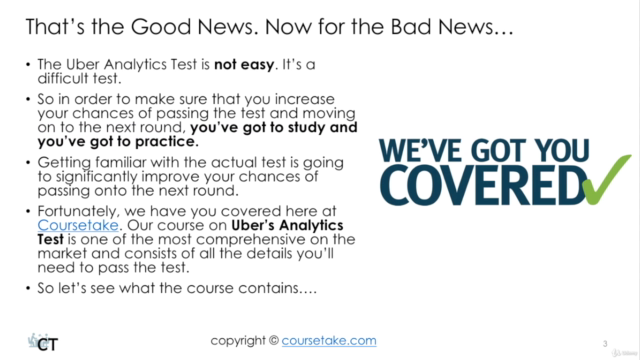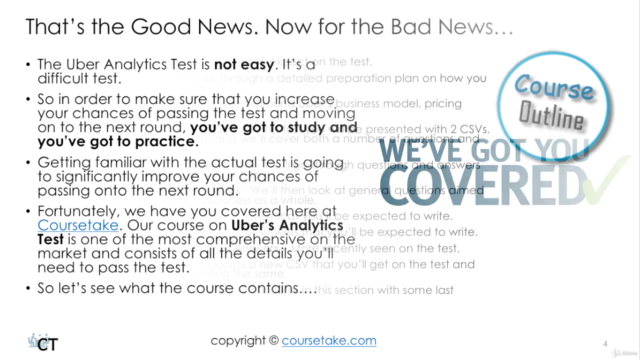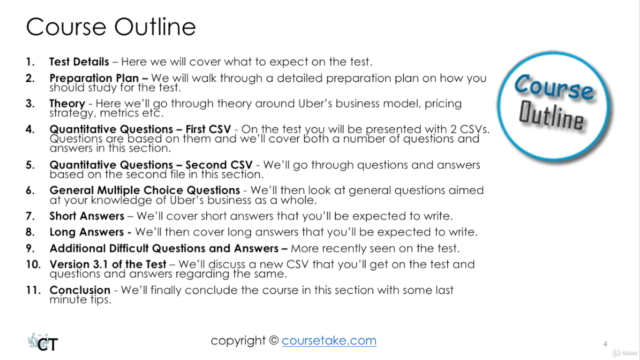Uber Analytics Test

Why take this course?
Uber Positions Overview
-
Operations and Logistics: This role focuses on the day-to-day management of the Uber platform, ensuring that operations run smoothly. It involves overseeing driver operations, handling logistical challenges, and implementing strategies to improve efficiency.
-
Marketing Manager: The marketing manager at Uber is responsible for developing and executing marketing campaigns, analyzing market trends, and working on brand strategy. They also engage with customers and partners to enhance the company's presence and growth.
-
General Manager: A general manager oversees the entire operations of a city or region, including driver acquisition, performance management, and partnership development. They set strategic goals and ensure that the local business meets its targets.
-
Associate General Manager: This position is similar to that of a general manager but may focus on specific aspects of the business like market expansion, operations, or product strategy. They work closely with regional teams and report to the General Manager.
-
Marketing Manager: As previously mentioned, this role involves crafting marketing strategies, managing campaigns, and engaging with both customers and partners to grow Uber's presence in the market.
Surge Pricing Explained
Surge pricing, also known as surge pricing, is a dynamic pricing model used by Uber during times of high demand. The idea is to balance supply and demand by temporarily increasing prices when there are more ride requests than available drivers. This not only incentivizes more drivers to hit the road but also ensures riders can get a ride despite peak demand periods.
Uber Metrics and Terms
- Completed Trips: The number of rides that have been successfully completed.
- Demand: The total number of ride requests during a given period.
- Dispatch: The process by which Uber matches passengers with drivers.
- Driver: An individual who uses their personal vehicle to provide transportation services on the Uber platform.
- Driver Supply: The availability of drivers willing and able to work at any given time.
- ETA (Estimated Time of Arrival): The estimated time it will take for a driver to reach the rider's location.
- Eyeballs: A term used to describe the number of active users or potential customers who are 'seeing' Uber's services or ads.
- Fare: The total cost of a trip, including any surge pricing multipliers.
- Idle Time: The time during which drivers are logged in but have not accepted any ride requests.
- Peak Hours: The hours with the highest demand for rides, usually coinciding with rush hour or local event times.
- Requests: The individual ride requests from passengers.
- Rider: A person who uses Uber services to request and take a ride.
- Working Shifts: The scheduled time periods during which drivers are available to work.
- Zeros: A term that may refer to the number of rides completed in a given period or a metric used for measuring driver activity.
Sample MCQs from the Uber Excel Analytics Test
-
Between February 1st and 5th, the date with the most completed trips is:
- A) February 3rd
- B) February 2nd
- C) February 4th (Most completed trips typically fall on weekdays as people commute.)
-
The hour of the day with the most completed trips on February 11th is:
- A) 7 AM to 8 AM
- B) 6 PM to 7 PM
- C) Data not available (This would depend on the specific data set.)
-
The least number of requests in one hour during a 15-day period was at:
- A) 2 AM to 3 AM
- B) 10 PM to 11 PM
- C) Data not available (This would depend on the specific data set.)
-
The percentage of all eyeballs that occurred on Fridays is approximately:
- A) 15%
- B) 25%
- C) Data not available (This would depend on the specific data set.)
-
The weighted average of requests per driver for the 15-day period is about:
- A) 3 requests/driver
- B) 8 requests/driver
- C) Data not available (This would depend on the specific data set and method of weighting.)
Additional Questions Covering Version 3.1 of the Test
The version 3.1 of the test might include more complex scenarios and data analysis questions. Here are some examples:
-
An Uber driver in a certain city earned $200 on a Saturday during peak hours with surge pricing. If the average fare without surge pricing is $15, what was the total surge multiplier applied during that day?
-
Given that the total number of active drivers in a region increased by 20% from last month, and the total number of completed trips also increased by 25%, how would you explain this trend?
-
If Uber's marketing campaign for the current quarter aims to increase ride requests by 15%, what metrics would you track to measure the success of this campaign?
-
How would you calculate the break-even point for an Uber driver in terms of both time and revenue?
-
What are the potential factors that could lead to a high rate of "Zeros" (no rides) among drivers during certain hours, and how might Uber address this issue?
Remember, these questions and roles are based on information available up to my knowledge cutoff date in early 2023. The actual test and job roles may have evolved since then.
Course Gallery




Loading charts...